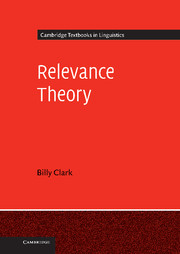Book contents
- Frontmatter
- Contents
- List of Figures and tables
- Preface
- Acknowledgements
- Typographical conventions
- Part I Overview
- Part II Details and developments
- 5 Explicature and implicature
- 6 Types of explicature
- 7 Types of implicature
- 8 Lexical pragmatics
- 9 Figurative language: metaphor
- 10 Figurative language: irony
- 11 Linguistic semantics
- 12 Conclusion: applications and recent developments
- Appendix Key notions of relevance theory
- Notes to chapters
- Bibliography and other resources
- Index
9 - Figurative language: metaphor
from Part II - Details and developments
Published online by Cambridge University Press: 05 June 2013
- Frontmatter
- Contents
- List of Figures and tables
- Preface
- Acknowledgements
- Typographical conventions
- Part I Overview
- Part II Details and developments
- 5 Explicature and implicature
- 6 Types of explicature
- 7 Types of implicature
- 8 Lexical pragmatics
- 9 Figurative language: metaphor
- 10 Figurative language: irony
- 11 Linguistic semantics
- 12 Conclusion: applications and recent developments
- Appendix Key notions of relevance theory
- Notes to chapters
- Bibliography and other resources
- Index
Summary
Topics: literal and non-literal language; descriptive and interpretive representations; Grice's account of metaphor; metaphor and weak implicatures; metaphor and ad hoc concepts
Overview
This chapter and the next one consider how relevance theory aims to account for two varieties of figurative language: metaphor and irony. There is a wide range of kinds of figurative language (for discussion, see Gibbs 1994; Glucksberg 2001) but these are by far the most extensively studied. This chapter begins by considering the traditional distinction between literal and non-literal language. Work in relevance theory rejects the traditional view on which there is a sharp distinction between utterances which are literal and utterances which are non-literal. It also rejects the assumption that there is a clear distinction between these phenomena and other kinds of utterances. Instead, they assume that ‘metaphorical’ and ‘ironic’ utterances (or utterances we label as such) exploit features which occur in a range of utterances, and that utterances can be more or less metaphorical or ironic depending on how they exploit these features. Given these assumptions, it is possible for some utterances to share some of the features of metaphor or irony without being clearly classifiable as metaphorical or ironic. One way to express this is to say that neither metaphor nor irony are ‘natural kinds’. Partly as a result of the work discussed in the previous chapter, the relevance-theoretic approach to literalness has changed over the years. Section 9.2 briefly considers Grice's account of non-literal language and points out some problems with his approach. Section 9.3 considers the distinction between descriptive and interpretive representations and shows how relevance theory exploits these two modes of representation in accounting for a variety of utterances.
- Type
- Chapter
- Information
- Relevance Theory , pp. 253 - 279Publisher: Cambridge University PressPrint publication year: 2013



